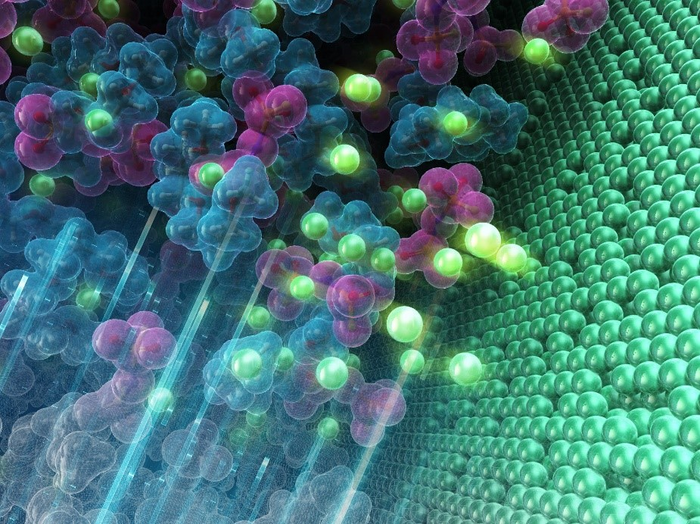Reviewed by Mila PereraOct 28 2022
According to a team of researchers, the lithium metal electrode and electrolyte in lithium metal batteries can now be stabilized through a new method. The energy density of batteries, the amount of energy stored in relation to the weight or volume, can be significantly improved by this new mechanism, which does not rely on the conventional kinetic approach.

The high reactivity of lithium metal reduces the electrolyte at its surface, thereby leading to the degradation of lithium metal battery performance. To overcome this issue, scientists have developed functional electrolytes and electrolyte additives to form a surface protective film, which impacts the safety and efficiency of lithium batteries, but this was still not efficient to prevent certain severe side reactions. In the current study, researchers stabilized the lithium metal and electrolyte by designing the electrolyte providing upshifted oxidation-reduction potential of lithium metal, thus succeeding in weakening the reaction activity of lithium metal thermodynamically, which could help achieve better battery performance. Image Credit: Yamada & Kitada Lab., Department of Chemical System Engineering, The University of Tokyo
The study was published in the journal Nature Energy.
Lithium metal batteries, a promising technology, can potentially satisfy the demand for high-energy-density storage devices. The low Coulombic efficiency of these batteries is caused by persistent electrolyte decomposition.
The battery’s ability to transmit electrons is measured by the Coulombic efficiency, commonly known as the current efficiency. This means that a battery with high Coulombic efficiency has a longer cycle life.
This is the first paper to propose electrode potential and related structural features as metrics for designing lithium-metal battery electrolytes, which are extracted by introducing data science combined with computational calculations. Based on our findings, several electrolytes, which enable high Coulombic efficiency, have been easily developed.
Atsuo Yamada, Professor, Department of Chemical System Engineering, University of Tokyo
The team’s work could open up new possibilities for developing lithium metal battery electrolytes in the future.
In lithium-ion batteries, during charging and discharging, lithium ions travel through the electrolyte from the positive electrode to the negative electrode. The energy density of the battery can be increased by adding high-energy-density electrodes.
Numerous investigations have been performed to replace the negative graphite electrode with lithium metal. However, due to the lithium metal's high reactivity, the electrolyte at its surface is reduced, meaning that the lithium metal electrode has a low Coulombic efficiency.
Scientists have created functional electrolytes and electrolyte additives that create a surface-protective film to solve this issue. This solid electrolyte interphase impacts the safety and effectiveness of lithium batteries.
The surface protective film kinetically slows the electrolyte reduction by preventing direct contact between the electrolyte and the lithium metal electrode. However, the relationship between the solid electrolyte interphase and the Coulombic efficiency was not fully recognized until recently.
Scientists are aware that increasing the solid electrolyte interphase’s stability can reduce the rate of electrolyte decomposition and raise the battery’s Coulombic efficiency. However, it is challenging for researchers to directly examine solid electrolyte interphase chemistry despite modern technology.
Most research on the solid electrolyte interphase has been performed using indirect methods. It is challenging to create the lithium metal that stabilizes the electrolyte and results in high Coulombic efficiency since these investigations only offer indirect evidence.
The study team concluded that increasing the lithium metal’s oxidation-reduction potential in a particular electrolyte system would minimize the thermodynamic driving force required to reduce the electrolyte and produce a higher Coulombic efficiency. This approach had rarely been used in the development of lithium metal batteries.
The thermodynamic oxidation-reduction potential of lithium metal, which varies significantly depending on the electrolytes, is a simple yet overlooked factor that influences the lithium metal battery performance.
Atsuo Yamada, Professor, Department of Chemical System Engineering, University of Tokyo
The group investigated the lithium metal’s capability for oxidation and reduction in 74 different electrolytes. As an internal standard for electrode potentials recommended by the IUPAC (International Union of Pure and Applied Chemistry), the researchers added a compound called ferrocene to all of the electrolytes.
The group established a link between lithium metal’s oxidation-reduction potential and Coulombic effectiveness. With the lithium metal’s upshifted oxidation-reduction potential, they achieved high Coulombic efficiency.
The study team’s long-term objective is to fully understand the logical mechanism underlying the oxidation-reduction potential shift.
We will design the electrolyte guaranteeing a Coulombic efficiency of greater than 99.95%. The Coulombic efficiency of lithium metal is less than 99%, even with advanced electrolytes. However, at least 99.95% is required for the commercialization of lithium metal-based batteries.
Atsuo Yamada, Professor, Department of Chemical System Engineering, University of Tokyo
The study was conducted in collaboration with the Nagoya Institute of Technology.
This study was supported by grants from the Ministry of Education, Culture, Sports, Science, and Technology Program: Data Creation and Utilization Type Materials Research and Development Project, the Japan Science and Technology Agency’s Specially Promoted Research for Innovative Next Generation Batteries, the JSPS KAKENHI Specially Promoted Research, and the Advanced Low Carbon Technology Research and Development Program.
Journal Reference
Ko, S., et al. (2022) Electrode potential influences the reversibility of lithium-metal anodes. Nature Energy. doi:10.1038/s41560-022-01144-0.